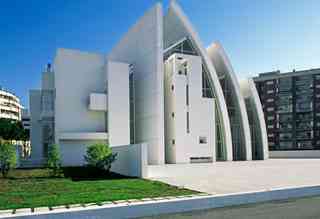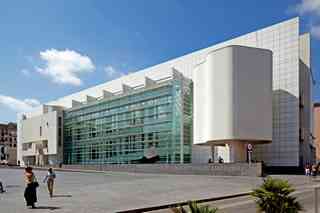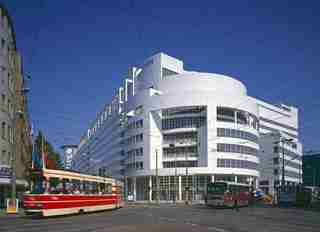
One of the New York Five, the famed group of progressive modernist architects, Richard Meier gained international recognition—not to mention a Pritzker Prize in 1984—for his abstract geometric designs, masterful use of light, and signature gleaming white buildings. After studying architecture at Cornell University, he worked for Skidmore, Owings & Merrill and then for Marcel Breuer before striking out on his own. He first attracted worldwide attention for the Getty Center in Los Angeles, the sprawling museum complex completed in 1997. Works such as the Barcelona Museum of Contemporary Art and City Hall for The Hague, Netherlands, as well as various residential projects, have affirmed his status as one of the most visionary architects of our time. Here, Architectural Digest rounds up some of his most celebrated projects, recognized for their inspiring designs and unparalleled contribution to the world of modern architecture.
Shown: Known informally as the Jubilee Church, the Church of God the Merciful Father in Rome was completed in 2003 with distinctive walls that gently curve toward the building’s center. Designed to reflect sunlight to regulate the structure’s internal temperature, the concrete walls contain titanium dioxide that not only keeps them pristine white but also reacts with UV rays to break down air pollutants.

Opened to the public in 1995, the Barcelona Museum of Contemporary Art was referred to as the Pearl by the city’s news media because of its luminous exterior of concrete and white enamel-coated steel. With a three-story atrium and smooth geometry, the structure, designed in homage to the modernist architectural movement, stands in stark contrast to the Gothic buildings in the area" or similar.

Nicknamed the Ice Palace by locals for its pristine color, the City Hall and Central Library of The Hague, Netherlands, was completed in 2005 with a circular library and an internal atrium. Clad in porcelain-enameled metal, the sprawling building also contains space for the city council, stores, cafés, exhibitions, and weddings.
Rome’s Museum of the Ara Pacis, completed in 2006, contains the namesake altar of Augustus, built in dedication to Pax, the Roman goddess of peace. Made using steel, travertine, and glass, the building also features exhibition space, a digital library, a café, and rooftop terrace.
Completed in 1997, the Getty Center is best known for its branch of the Getty Museum (shown), although it also contains the Getty Research Institute, the Getty Conservation Institute, the Getty Foundation, and the J. Paul Getty Trust. The cultural complex, located in the Brentwood neighborhood of Los Angeles, includes many fountains to provide ambient noise.
Schwendi, Germany, is home to the Weishaupt Forum, an industrial complex designed for its namesake HVAC company completed in 1993. The building’s graceful form, set against the surrounding countryside, contains a training center and cafeteria for employees, as well as exhibition space to display a private collection of contemporary art.
Museum Frieder Burda, located in Baden-Baden, Germany, was completed in 2004 to house the private collection of the art patron for whom it’s named. Designed to be a “daylight museum,” the structure incorporates glass into its exterior to bathe the galleries in natural light.
Located in a cultural district of Frankfurt, the Museum for Decorative Arts is an L-shaped structure that surrounds the Villa Metzler, the museum’s original building that was once an apothecary. Meier’s signature use of natural light floods the interior of the structure, which contains works focused on design, fashion, and performance art.
This glass rotunda serves as the entrance to the San Jose City Hall in California, a complex with an office tower to the east and council chambers to the west. Designed to be a civic plaza, the site sits at the center of a redeveloped part of the city with a performance hall, school, and library.
The flagship store of Peek & Cloppenburg in Dusseldorf, Germany, has a sweeping glass façade to showcase the luxury goods within. Opened in 2007, the retail destination achieves its airy feel with the addition of a brise-soleil on the top floor and a cylindrical skylight illuminating the interior.
